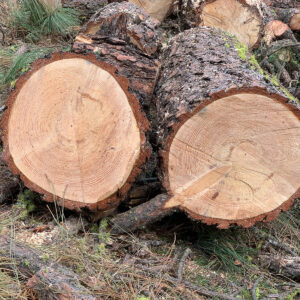Living outside Spokane Washington, we don’t have access to Eastern White Pine. Ponderosa Pine is the native tree on my property. I wonder if anyone who has worked with both would share their experience. I’m sure that Ponderosa would be more resinous, but the working properties could be similar.
In the last few years when I cut up a big tree, I cut a 6 foot section, then with my chainsaw, rip it down the middle – through the pith. Then paint the ends, raise it off the ground with the bark up. After a year or two it is dry as a bone ( in the summer our humidity is about 10%). Then cut it into boards with my chain saw – usually quartersawn. I’ve used it for drawer bottoms, boxes etc.
Not elegant or efficient, but otherwise would be firewood.
I had a 22″ tree snap off in a winter windstorm. I’m still working on it.
Discussion Forum
Get It All!
UNLIMITED Membership is like taking a master class in woodworking for less than $10 a month.
Start Your Free TrialCategories
Discussion Forum
Digital Plans Library
Member exclusive! – Plans for everyone – from beginners to experts – right at your fingertips.
Highlights
-
Shape Your Skills
when you sign up for our emails
This site is protected by reCAPTCHA and the Google Privacy Policy and Terms of Service apply. -
 Shop Talk Live Podcast
Shop Talk Live Podcast -
 Our favorite articles and videos
Our favorite articles and videos -
E-Learning Courses from Fine Woodworking
-
-
 Fine Woodworking New England Event
Fine Woodworking New England Event -













Replies
I have never worked with it, but it looks a lot like southern yellow pine rather than white pine. SYP is stronger but tends to warp. Do you have sugar pine? I read in Megan Fitzpatrick's blog entries that it is comparable to eastern white pine. It should be much more stable and easier to work. I have used eastern white pine when making bee hive boxes from kits and it is very stable and good to work.
No sugar pine on the east side of the cascades. Too dry.
From what I’ve read SYP is much heavier and stronger.
No sugar pine on the east side of the cascades. Too dry.
From what I’ve read SYP is much heavier and stronger.
Sugar pine and Eastern white pine are nearly identical in weight and Janka hardness, and are at the lowest end of hardness for commonly available pines. Janka is 380 for both.
Southern yellow pine is at the high end for weight and hardness for the common pines. Janka is 870.
Ponderosa pine is an excellent secondary wood. It's at the low end for weight and hardness, with the Janka score at 460.
Like SYP in the Southeast, Ponderosa Pine (PP) is a common construction timber wood. It’s, as suggested already, more or less an “in-between” species, having some characteristics of a yellow pine, but others more towards the softer white pine end of things. It’s not as hard or sturdy as Douglas Fir, another common construction timber of the Northwest especially, but not far off, either. Both machine well, take stain/finish well, and are pretty stable when dry, though not in the same league as white pine.
I think both are under-appreciated and under-utilized. Their common use as construction lumber is, I believe, irrationally held against them too often. Construction lumber can have a good face for a radio career, but that doesn’t mean that all examples of a species will be like that. Frankly, most American cedar has a much worse appearance, in my opinion, yet we see it turned into furniture frequently—often with portions unsuited to construction purposes, being repurposed for “rustic furniture”. Cedar smells good, though, and is famous for its slow decay. But for, say, cabin furniture, PP, DF, and others are at least as good, and often better, easier to work, and less expensive.
As a final comment, I’ll offer this: Flaws in a given work are never due to the wood, but should always be credited to the maker. A tree doesn’t grow up wanting to be a highboy or a side table. It is we who turn it into those. We should credit the tree, or the wood, for the wonderful thing it is, and not blame it for what it is not.
I'm in the PNW also and have easy access to Ponderosa. I have bought it extensively for school. We have used many many whole units of 12' 1x12. It is harder than our western white pine, the latewood ring layer is more dense like a doug fir and it is definitely more resinous than western white pine or doug fir. It also has a more distinct heartwood color.
I like it a lot, however I have switched over to western white pine because of the resin gumming up machines and usually tighter grain of the western white pine. Cost is pretty similar between each here.
Thanks for all the info.
Looks like you got hit with the first storm. . . . or was it the 2nd, 71 mph one? We don't have any PP on our property, but did lose a ca. 100 year old arbor vitae and two large branches of a century old cherry tree in the past. Just FYI for everyone, the Coniferous Forest website has an egregious error on the Ponderosa Pine page : "The deep taproot system of ponderosa pines makes them wind-resistant." Anyone living in the Inland NW can attest to the fact that these are NOT wind resistant, and do not have a deep taproot system.
This forum post is now archived. Commenting has been disabled